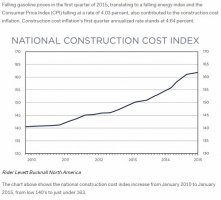Nothing to see here, move on. Just another trend in the season of floods, fires, inflation, housing bubble, etc.
 https://www.architectmagazine.com/design/construction-costs-in-the-us-are-rising_o
Building Materials
https://www.architectmagazine.com/design/construction-costs-in-the-us-are-rising_o
Building Materials
July 15, 2013 1
Crowe's Economy
MATERIAL PRICES UP
A typical home's total materials costs increased 5 percent during the past six months; higher in the South and West.
By
David Crowe
Home building material prices soared earlier this year although some calm arrived recently. Material costs account for about one-third of a new home’s selling price, so a 10 percent rise in material costs equates to an average $8,500 price increase per house. The current conservative appraisal environment makes that kind of increase near impossible. Two recent NAHB surveys highlight the extent of these trends and the materials most affected.
The NAHB surveyed builders and building material sellers, in cooperation with the National Lumber and Building Material Dealers Association, on what commodities they bought and the degree of price movement they experienced during the past six months.
Builders said they most often purchased framing lumber, windows, doors, millwork, gypsum, and roofing materials. They cited that the materials experiencing recent price increases include (in the order of largest percentage): framing lumber, OSB, plywood, gypsum, trusses, ready-mix concrete, roofing materials, and cement. There were no major differences across the four census regions or three sizes (by number of starts) of builders.
Surveyed dealers’ most frequent purchases were OSB, framing lumber, plywood, windows, doors, millwork, gypsum, and insulation. Dealers listed the same top five materials, but a larger share saw increased pricing. They also were more likely than builders to receive higher prices for insulation, SIPs, windows, and doors. Differences in gross sales levels did not appear to affect the dealers’ experiences.
The five materials most cited by builders for price increases also showed the greatest change in builders experiencing an increase. In mid 2012, 58 percent of builders saw framing lumber increase but by mid 2013, the share rose to 92 percent. The share of builders seeing price increases in OSB and plywood rose by one-third and the share seeing truss price increases rose from 51 percent to 80 percent.
Supporting Indexes Independent measures that produce price indexes support the builders’ and dealers’ experiences. From May 2012 to May 2013, softwood lumber was up 26 percent, OSB was up 74 percent, plywood increased 14 percent, and gypsum was up 19 percent while the entire bundle of building materials used in a home were up less than 2 percent. Some softening has occurred in more recent reports.
The near universally purchased materials had some of the largest price increases while some materials saw much smaller changes. Builders reported that a typical home’s total building material cost increased 5 percent over the past six months. Larger builders (100 or more starts per year) experienced an average 5.6 percent increase, and costs increased the most in the South and West.
Building material dealers responded with a much higher (more than 10 percent) increase in the past six months for the materials they sell. Some of the differential can be explained by the narrower range of materials many of the dealers sell. Most dealers concentrate sales in materials with the greatest price increases and many did not sell products such as plumbing fixtures, brick, concrete, and steel, which had some of the smallest price increases.
A number of potential forces appear to have caused these increases at a time when home building is barely halfway back to a normal production level. Manufacturers of building materials experienced the same collapse in their markets as builders did. After ramping up capacity to supply the construction of more than 2 million homes a year, home building fell to barely 0.5 million. All of the resources, labor, factories, trucks, raw materials, and capital went idle or found other industries or markets. For instance, timber went to China, workers went to energy production, and manufacturing facilities were scraped.
As production comes back, these resources will return but it will take time. The slow housing rebound may be a blessing in disguise giving the rest of the housing support system time to rebuild.
https://www.builderonline.com/products/building-materials/material-prices-up_o
